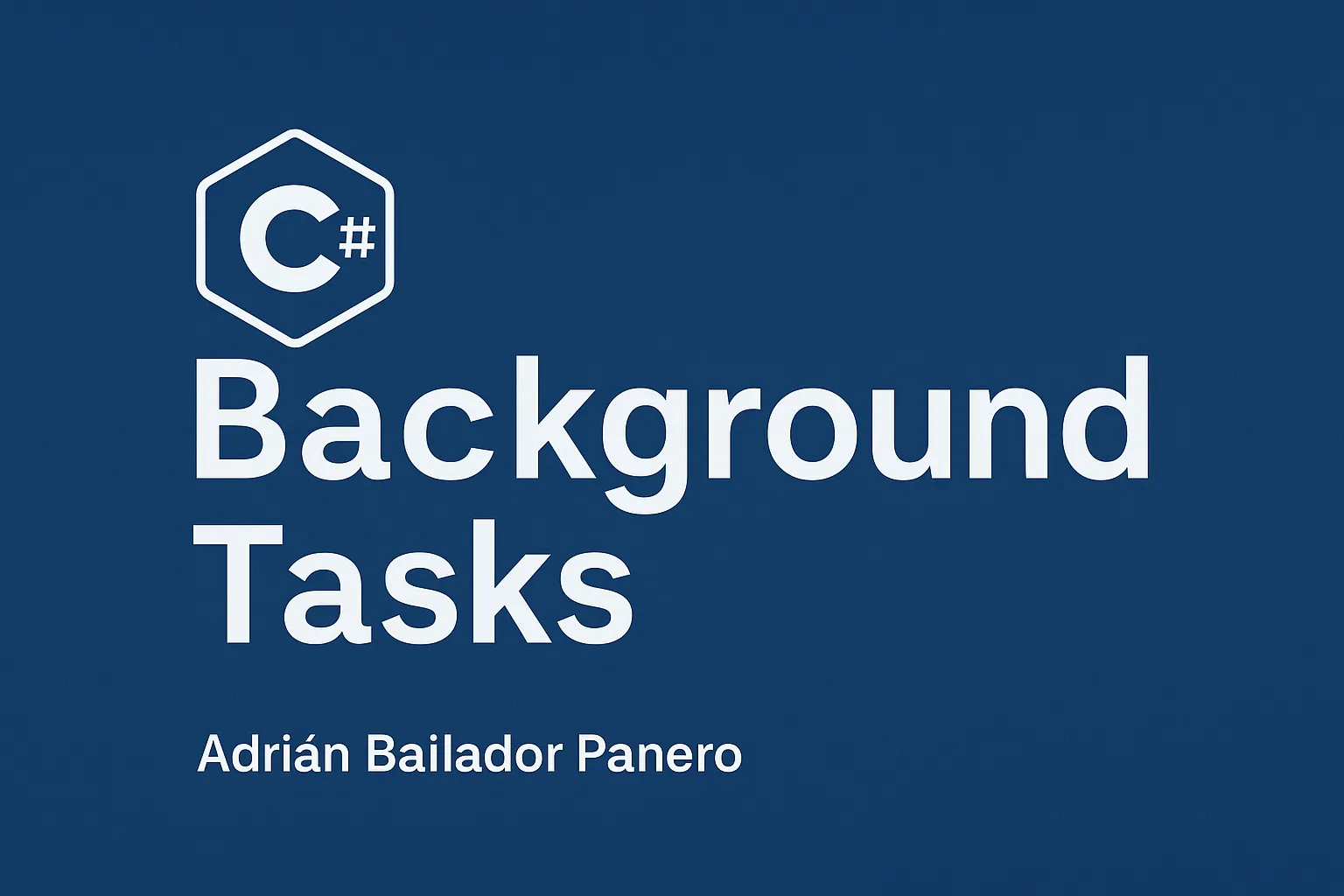
In this article, we’ll explore the different ways to run tasks in the background in C#, including:
Task.Runfor simple async operations.BackgroundServicefor long-running services in ASP.NET Core.IHostedServicefor more controlled services.- Queued background tasks using
IBackgroundTaskQueue.
We’ll also provide a working example you can use as a starting point in your projects.
🧠 Why Use Background Tasks?
Background tasks are useful for:
- Offloading long-running operations (e.g. report generation, image processing).
- Avoiding blocking the main thread in APIs or UI apps.
- Running scheduled or periodic jobs (e.g. sending emails, syncing data).
- Handling async operations in a scalable way.
🔹 1. Using Task.Run for Lightweight Background Work
If you need to run a simple piece of work in the background, Task.Run is the quickest way:
public async Task ProcessImageAsync(string imagePath)
{
await Task.Run(() =>
{
// Simulate long processing
Thread.Sleep(2000);
Console.WriteLine($"Processed image: {imagePath}");
});
}⚠️ Note: Avoid using Task.Run for CPU-intensive or long operations in ASP.NET apps—it’s better suited for quick, non-blocking tasks.
🔹 2. Creating a Background Service with BackgroundService
For more robust needs, like polling or continuous background work in ASP.NET Core, use BackgroundService.
public class WorkerService : BackgroundService
{
private readonly ILogger<WorkerService> _logger;
public WorkerService(ILogger<WorkerService> logger)
{
_logger = logger;
}
protected override async Task ExecuteAsync(CancellationToken stoppingToken)
{
while (!stoppingToken.IsCancellationRequested)
{
_logger.LogInformation("Worker running at: {time}", DateTimeOffset.Now);
await Task.Delay(5000, stoppingToken);
}
}
}Register it in Program.cs:
builder.Services.AddHostedService<WorkerService>();🔹 3. Implementing IHostedService Manually
If you need more control over lifecycle methods, implement IHostedService directly:
public class TimedService : IHostedService, IDisposable
{
private Timer _timer;
public Task StartAsync(CancellationToken cancellationToken)
{
_timer = new Timer(DoWork, null, TimeSpan.Zero, TimeSpan.FromSeconds(10));
return Task.CompletedTask;
}
private void DoWork(object state)
{
Console.WriteLine($"Work executed at {DateTime.Now}");
}
public Task StopAsync(CancellationToken cancellationToken)
{
_timer?.Change(Timeout.Infinite, 0);
return Task.CompletedTask;
}
public void Dispose()
{
_timer?.Dispose();
}
}🔹 4. Queued Background Tasks with Channels
You can create a queue of background tasks using a producer-consumer pattern.
Interface:
public interface IBackgroundTaskQueue
{
void Enqueue(Func<CancellationToken, Task> workItem);
Task<Func<CancellationToken, Task>> DequeueAsync(CancellationToken cancellationToken);
}Implementation:
public class BackgroundTaskQueue : IBackgroundTaskQueue
{
private readonly Channel<Func<CancellationToken, Task>> _queue = Channel.CreateUnbounded<Func<CancellationToken, Task>>();
public void Enqueue(Func<CancellationToken, Task> workItem)
{
_queue.Writer.TryWrite(workItem);
}
public async Task<Func<CancellationToken, Task>> DequeueAsync(CancellationToken cancellationToken)
{
return await _queue.Reader.ReadAsync(cancellationToken);
}
}Worker:
public class QueuedHostedService : BackgroundService
{
private readonly IBackgroundTaskQueue _taskQueue;
public QueuedHostedService(IBackgroundTaskQueue taskQueue)
{
_taskQueue = taskQueue;
}
protected override async Task ExecuteAsync(CancellationToken stoppingToken)
{
while (!stoppingToken.IsCancellationRequested)
{
var workItem = await _taskQueue.DequeueAsync(stoppingToken);
await workItem(stoppingToken);
}
}
}Register in Program.cs:
builder.Services.AddSingleton<IBackgroundTaskQueue, BackgroundTaskQueue>();
builder.Services.AddHostedService<QueuedHostedService>();Use in API Endpoint:
app.MapPost("/enqueue", (IBackgroundTaskQueue queue) =>
{
queue.Enqueue(async token =>
{
await Task.Delay(3000, token);
Console.WriteLine("Background task finished.");
});
return Results.Ok("Task enqueued.");
});⚠️ Common Pitfalls
- ❌ Blocking the thread: Don’t use
Thread.Sleepin async methods—useawait Task.Delay. - ❌ Using Task.Run in ASP.NET: Avoid it in web apps unless absolutely necessary—it uses up valuable thread pool resources.
- ❌ Forgetting cancellation: Always respect
CancellationTokenin long-running tasks.
✅ Best Practices
- Use
BackgroundServiceorIHostedServicefor background workers. - Use dependency injection to manage services within tasks.
- Respect cancellation tokens to allow graceful shutdown.
- Log exceptions in background tasks to avoid silent failures.
- Monitor performance and queue length in production.
🔗 Useful Links
- .NET BackgroundService Docs
- Queued Background Tasks in ASP.NET Core
- Microsoft.Extensions.Hosting NuGet package
For the full code and examples, visit my GitHub repository.